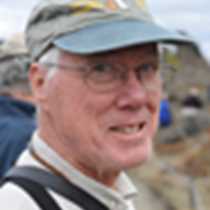Hinlopen Strait, Svalbard
Today was an “Expedition Day” in northern Svalbard. That means that we were not altogether sure what was going to happen, but we were confident that it would turn out to be interesting. And that is exactly what happened. We began our day heading south through Hinlopen Strait, a narrow passage between the two main islands of Svalbard: Spitsbergen and Nordaustlandet. At Cape Fanshawe on the Spitsbergen side there is an enormous colony of thick-billed murres (Brünnich’s Guillemots). We made a pre-breakfast stop here in the soft morning light. As we approached the cliffs the air and water were filled with black and white seabirds, coming and going, bringing food to their young.
The National Geographic Endeavour moved closer until we could see thousands of birds packed side by side on impossibly narrow ledges - their black sides out, white sides in. In this way the parent birds keep their single young pinned against the cliff so they will not take a premature tumble or be snatched by a marauding glaucous gull (in the upper right corner of the picture above.) It takes all the efforts of the two murre parents to raise a chick, one adult always tending while the other is away seeking food, and then they switch duties. Soon, their approach to child rearing will change. The young birds, not yet able to fly, will leap from the cliff into the water below and the fathers will lead them away from the colony to hopefully-rich feeding areas far at sea. It is a remarkable breeding system, and it works.
We left Cape Fanshawe heading further down Hinlopen Strait. There we encountered the ice – not the glacial ice that we experienced yesterday at Monacobreen but the remnants of last winter’s sea ice, now broken into flat pans of various sizes and moving with the wind and currents. The National Geographic Endeavour is a stout and sturdy ship, strengthened against the ice. Bravely we entered into it, pushing aside some pieces, breaking others. We were joined by an escort of kittiwakes feasting on polar cod that were washed from the underside of the ice by our passage. It was fascinating to watch and experience. In the end the ice won. Our experienced Captain made the wise decision to yield and reverse course, and so we did. Our plans for the trip will be revised and reorganized. And that is why they call it an expedition.
Today was an “Expedition Day” in northern Svalbard. That means that we were not altogether sure what was going to happen, but we were confident that it would turn out to be interesting. And that is exactly what happened. We began our day heading south through Hinlopen Strait, a narrow passage between the two main islands of Svalbard: Spitsbergen and Nordaustlandet. At Cape Fanshawe on the Spitsbergen side there is an enormous colony of thick-billed murres (Brünnich’s Guillemots). We made a pre-breakfast stop here in the soft morning light. As we approached the cliffs the air and water were filled with black and white seabirds, coming and going, bringing food to their young.
The National Geographic Endeavour moved closer until we could see thousands of birds packed side by side on impossibly narrow ledges - their black sides out, white sides in. In this way the parent birds keep their single young pinned against the cliff so they will not take a premature tumble or be snatched by a marauding glaucous gull (in the upper right corner of the picture above.) It takes all the efforts of the two murre parents to raise a chick, one adult always tending while the other is away seeking food, and then they switch duties. Soon, their approach to child rearing will change. The young birds, not yet able to fly, will leap from the cliff into the water below and the fathers will lead them away from the colony to hopefully-rich feeding areas far at sea. It is a remarkable breeding system, and it works.
We left Cape Fanshawe heading further down Hinlopen Strait. There we encountered the ice – not the glacial ice that we experienced yesterday at Monacobreen but the remnants of last winter’s sea ice, now broken into flat pans of various sizes and moving with the wind and currents. The National Geographic Endeavour is a stout and sturdy ship, strengthened against the ice. Bravely we entered into it, pushing aside some pieces, breaking others. We were joined by an escort of kittiwakes feasting on polar cod that were washed from the underside of the ice by our passage. It was fascinating to watch and experience. In the end the ice won. Our experienced Captain made the wise decision to yield and reverse course, and so we did. Our plans for the trip will be revised and reorganized. And that is why they call it an expedition.


